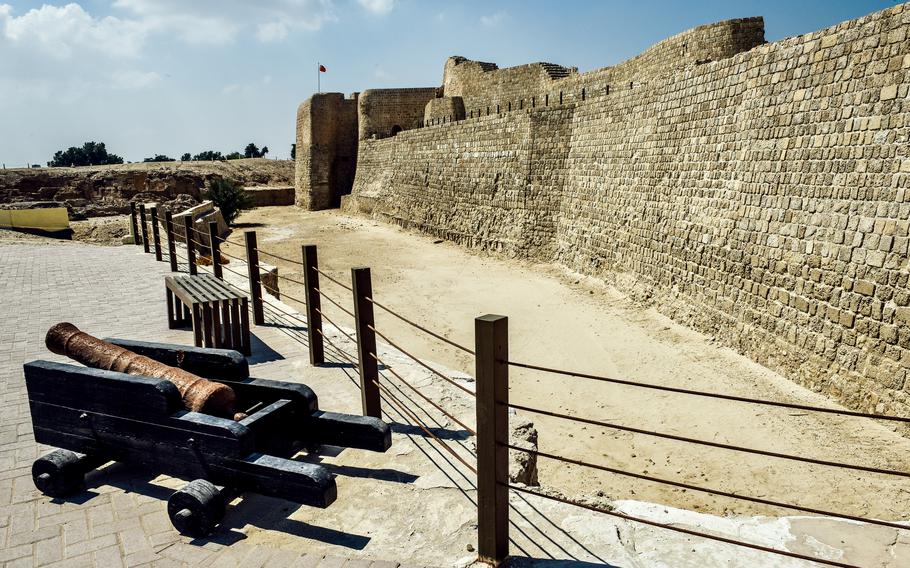
Cannons were used under Portuguese control of the Bahrain Fort in the 16th century. The Portuguese occupied Bahrain in 1521 and used it as part of their strategic defense. (Shannon Renfroe/Stars and Stripes)
My recent visit to one of Manama’s must-see attractions began in disappointment, as I arrived at the Bahrain Fort only to find the hulking ancient structure closed to visitors.
Also referred to as Qal’at al-Bahrain, the fort is a UNESCO World Heritage site where sightseers can glimpse 4,000 years of the history of the country, which hosts a significant U.S. military presence.
But since I couldn’t explore the fort itself, I went for a 15-minute walk along its perimeter before ending up at the museum connected to it.
The museum’s GB cafe provided a much-needed break after my trek in the heat. One of the best-known cafes on the island, GB serves cold drinks, homemade pastries and various lunch and dinner options.
It has an outdoor seating area shaded by towering palm groves and tables set along the coastline. The atmosphere felt distinctly Mediterranean and offered a pleasant escape from the Bahraini sun.
Before starting my museum tour, I ordered an iced rose tea and a multigrain croissant to recharge.
The museum was designed by Danish architect Claus Wohlert and boasts a sleek, minimalist construction that contrasts with the ancient fort.
It recently expanded its interactive displays and added educational panels, offering deeper engagement with the site’s history. Nearby, the Dilmun Hills Museum is in the works. It will focus on the ancient pottery found and highlight the craftsmanship of the Dilmun people.
Though smaller than most traditional museums, this one allowed me to absorb the information without feeling overwhelmed.
The history of what is Bahrain today began with the Dilmun period, spanning two phases, the first circa 3000 to 2000 BCE and the second, 2000 to 1600 BCE. It was followed by the Tylos, the Sassanian Empire and the Islamic period between 200 BCE and the 7th century.
Then came the Portuguese occupation, which lasted from 1521 until 1602 and was followed by the post-Portuguese era, where the island came under the control of the Safavid Empire of Persia.
In 1861, Bahrain became a British protectorate, where Britain took responsibility for all military and foreign affairs. It wasn’t until 1971 that Bahrain declared independence and in 2002, formally declared a kingdom. Evidence of all these periods is showcased.
There were two particularly notable things at the museum. One was a section dedicated to cannonballs and weapons, which underscored the fort’s defensive role over the centuries.
The other thing that stood out to me was a set of 15 steles discovered accidentally in 1991 in private gardens. Archaeologists are still unsure about their meaning.
Their style dates them to the 2nd or 3rd centuries. What stands out most is the peculiar positioning of their hands. Both male and female figures consistently raise their right hand, palm facing forward, as if in a gesture of prayer. The unresolved mystery lies in whether these steles held social or religious significance, and if they reflect a cross-cultural exchange between empires.
By the end of the visit, my disappointment over the Fort’s closing had vanished. I felt the thrill of a rewarding day of sightseeing and education, plus a tasty snack.
On the QT
Address: Building 3618, Road 3863, Block 438 Manama, Bahrain
Hours: Tuesday through Sunday, 8 a.m.-8 p.m.; Monday, closed
Cost: 2 dinars
Information: Online: culture.gov.bh/en/authority/cultural_sites/QalatAl-BahrainSiteMuseum